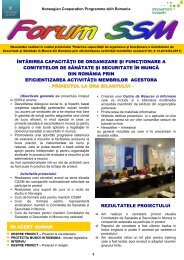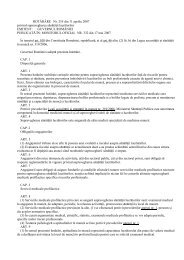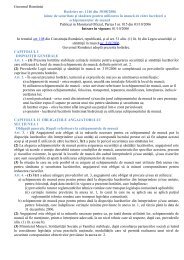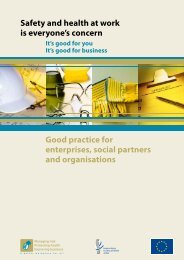Preventing work-related musculoskeletal disorders - European ...
Preventing work-related musculoskeletal disorders - European ...
Preventing work-related musculoskeletal disorders - European ...
Create successful ePaper yourself
Turn your PDF publications into a flip-book with our unique Google optimized e-Paper software.
<strong>Preventing</strong> <strong>work</strong>-<strong>related</strong> <strong>musculoskeletal</strong> <strong>disorders</strong><br />
Exposure indicator: strenuous <strong>work</strong>ing postures<br />
Potential health effects<br />
<strong>European</strong> picture 9<br />
Potentially can result in many health <strong>disorders</strong> affecting the bones, muscles and ligaments particularly vulnerable is the back. Potential for<br />
increased stress levels during <strong>work</strong> activities involving strenuous postures.<br />
45% of all <strong>work</strong>ers interviewed were exposed to strenuous <strong>work</strong>ing postures.<br />
Sector categories most at risk 45 Construction (12);<br />
from the national reports using 01 Agriculture, hunting and <strong>related</strong> service activities (7);<br />
NACE code 10 85 Health and social <strong>work</strong> (5);<br />
Figures in brackets represent the 93 Other service activities (4);<br />
number of Focal Point responses 17 Manufacture of textiles (4);<br />
15 Manufacture of food products and beverages (4).<br />
Occupation categories most at 93 Labourers in mining, construction, manufacturing and transport (9);<br />
risk from the national reports 71 Extraction and building trades <strong>work</strong>ers (6);<br />
using ISCO code 11<br />
Figures in brackets represent the 72 Metal, machinery and <strong>related</strong> trades <strong>work</strong>ers (6);<br />
number of Focal Point responses 92 Agricultural, fishery and <strong>related</strong> labourers (4);<br />
74 Other craft and <strong>related</strong> trades <strong>work</strong>ers (4);<br />
61 Skilled agricultural and fishery <strong>work</strong>ers (4).<br />
Other risk categories<br />
Trends<br />
Focal Points identifying the need<br />
for additional preventive action<br />
Description of indicated action 12<br />
Other relevant information<br />
No common description could be given.<br />
Although a limited response, five Focal Points reported a decreased trend in exposure to strenuous <strong>work</strong>ing postures. Two Focal Points reported<br />
a stable trend and a further two reported an increased trend in exposure to strenuous <strong>work</strong>ing postures in the <strong>work</strong>place. Six Focal Points were<br />
unable to establish a particular trend.<br />
Austria, Belgium, Finland, Italy, Spain and Sweden.<br />
No common description could be given.<br />
Strenuous <strong>work</strong>ing postures are of significant importance, especially when combined with lifting of heavy loads and repetitious <strong>work</strong> tasks.<br />
Inadequate <strong>work</strong>ing posture is a well-known aggravating factor causing <strong>disorders</strong> of the lower spine. Difficult <strong>work</strong>ing positions contribute to the<br />
potential risk of <strong>work</strong> induced <strong>musculoskeletal</strong> <strong>disorders</strong>. Musculoskeletal <strong>disorders</strong> are a common cause of early retirement.<br />
Difficult <strong>work</strong>ing positions are important factors contributing to the potential risk of <strong>musculoskeletal</strong> <strong>disorders</strong> in the <strong>work</strong>place. Musculoskeletal<br />
<strong>disorders</strong> are a common cause of early retirement.<br />
The prevention of strenuous postures in the <strong>work</strong>ing environment is <strong>related</strong> to an appropriate ergonomic design of the <strong>work</strong>place, <strong>work</strong>station,<br />
machinery and <strong>work</strong> organisation. Assessment of tasks and job rotation is fundamental to reducing the exposure to the risk. The implementation<br />
of new provisions on ergonomics for the protection against <strong>musculoskeletal</strong> <strong>disorders</strong> calls for more distinct supervisory activities. There is a<br />
need for improvement of the technical and organisational measures and of information and training.<br />
OSH outcome: <strong>musculoskeletal</strong> <strong>disorders</strong><br />
Potential health effects Injury to the muscular and skeletal systems of the body. Significant <strong>work</strong> induced <strong>musculoskeletal</strong> <strong>disorders</strong> commonly affect the lower back and<br />
the hands (tenosynovitis).<br />
<strong>European</strong> picture 13<br />
30% of all <strong>work</strong>ers interviewed were exposed to <strong>musculoskeletal</strong> <strong>disorders</strong><br />
Sector categories most at risk 45 Construction (7);<br />
from the national reports using 01 Agriculture, hunting and <strong>related</strong> service activities (6);<br />
NACE code 14 55 Hotels and restaurants (4);<br />
Figures in brackets represent the 85 Health and social <strong>work</strong> (3);<br />
number of Focal Point responses 28 Manufacture of fabricated metal products, except machinery and equipment (3);<br />
27 Manufacture of basic metals (3).<br />
Occupation categories most at 93 Labourers in mining, construction, manufacturing and transport (9);<br />
risk from the national reports 71 Extraction and building trades <strong>work</strong>ers (6);<br />
using ISCO code 15 91 Sales and services elementary occupations (5);<br />
Figures in brackets represent the 72 Metal, machinery and <strong>related</strong> trades <strong>work</strong>ers (5);<br />
number of Focal Point responses 92 Agricultural, fishery and <strong>related</strong> labourers (4);<br />
61 Skilled agricultural and fishery <strong>work</strong>ers (4).<br />
Other risk categories No common description could be given<br />
Trends Six Focal Points reported a stable trend in the exposure to <strong>musculoskeletal</strong> <strong>disorders</strong> whereas, five reported an increase and one a decrease.<br />
Only three Focal Points were unable to establish a particular trend.<br />
Focal Points identifying the Austria, Belgium, Denmark, Finland, Luxembourg, Portugal, Spain and Sweden.<br />
need for additional preventive<br />
action<br />
Description of indicated action 16<br />
Two Focal Points reported a lack of national data and the need to conduct surveys to collect such information.<br />
Other relevant information Musculoskeletal <strong>disorders</strong> are a major source of occupational injuries in the <strong>work</strong>ing environment.<br />
Occupational exposure to <strong>musculoskeletal</strong> <strong>disorders</strong> is one potential source that can result in an injury. Current lifestyles including healthy living,<br />
recreational and sporting activities also have a much more important causal connection, thereby contributing to the difficulty in establishing those<br />
that are solely attributable to <strong>work</strong>place conditions. Repetition and monotony combined with <strong>work</strong>ing conditions such as low individual control of<br />
the <strong>work</strong> and high <strong>work</strong>pace can also lead to an increase in the risk of <strong>musculoskeletal</strong> <strong>disorders</strong>.<br />
It is expected that still more and better mechanical lifting aids will be developed in the future.<br />
The prevalence of <strong>musculoskeletal</strong> <strong>disorders</strong> among the active and younger age categories does not reflect the impact of <strong>work</strong> <strong>related</strong> symptoms<br />
in the oldest age group.<br />
The <strong>European</strong> Agency’s report on The State of Occupational and Health in the <strong>European</strong> Union is available on line at http://agency.osha.eu.int/publications/reports/stateofosh<br />
9<br />
ESWC-data, 2nd Survey Dublin 1996.<br />
10<br />
The most frequently identified sectors which the Focal Points considered to be most at risk.<br />
11<br />
The most frequently identified occupations which the Focal Points considered to be most at risk.<br />
12<br />
The descriptions of further actions can be found in the individual chapters dealing with the exposure or OSH outcome.<br />
13<br />
ESWC-data, 2nd Survey Dublin 1996.<br />
14<br />
The most frequently identified sectors which the Focal Points considered to be most at risk.<br />
15<br />
The most frequently identified occupations which the Focal Points considered to be most at risk.<br />
16<br />
The descriptions of further actions can be found in the individual chapters dealing with the exposure or OSH outcome.<br />
<strong>European</strong> Agency for Safety and Health at Work<br />
9








